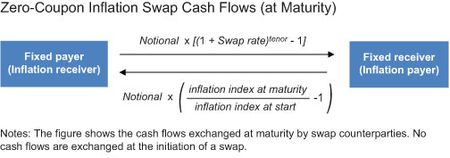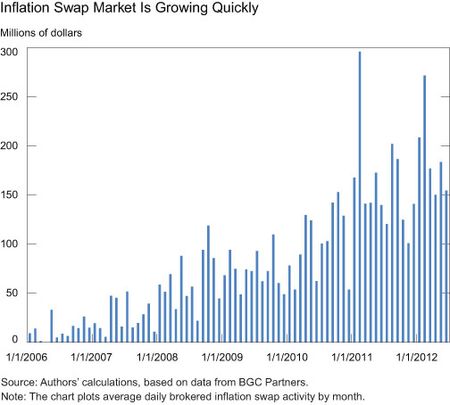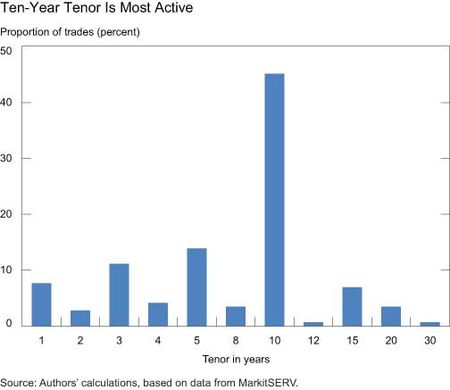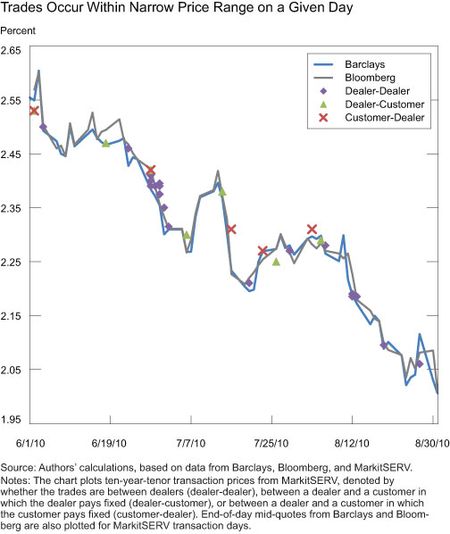Michael J. Fleming and John Sporn
Inflation swaps are used to transfer inflation risk and make inferences about
the future course of inflation. Despite the importance of this market to
inflation hedgers, inflation speculators, and policymakers, there is little
evidence on its liquidity. Based on an analysis
of new and detailed data in this post we show that the market appears
reasonably liquid and transparent despite low trading activity, likely
reflecting the high liquidity of related markets for inflation risk. In a previous
post, we examined similar issues for the broader interest rate derivatives
market.
Inflation Swaps Defined
An inflation swap is a derivatives transaction in which one party agrees to
swap fixed payments for floating payments tied to an inflation rate for a given
notional amount and period of time. For example, an investor might agree to pay
a fixed per annum rate of 2.5 percent on a $25 million notional amount for ten
years in order to receive the rate of inflation for that same time period and
amount. The inflation gauge for U.S. dollar inflation swaps is the
nonseasonally adjusted consumer price index for urban consumers.
The figure below illustrates the
cash flows for a zero-coupon inflation swap—the most common inflation swap in the U.S.
market. As the name “zero-coupon” swap implies, cash flows are exchanged at
maturity of the contract only. The fixed rate (the swap rate) is negotiated in
the market so that the initial value of a trade is zero. As a result, no cash
flows are exchanged at the inception of a swap.
Market Is Modest in Size, but Growing
Quickly
Evidence suggests that the U.S. inflation swap market is modest in size,
but growing quickly. As shown in the chart below, data from BGC Partners, a
leading broker, indicates that interdealer trading of zero-coupon swaps
averaged roughly $100 million per day in 2010, $160 million per day in 2011,
and $190 million per day in the first half of 2012. Data from an informal survey of dealers—accounting
for activity with customers as well as activity brokered among dealers—peg
the overall market size in April 2012 at roughly $350 million per day.
Transaction Data Point to Low Trade
Frequency
The bulk of our analysis is based on inflation swap transactions between
June 1 and August 31, 2010, in which a major derivatives dealer was on at least
one side of the resulting position. The data come from MarkitSERV, the
predominant trade-matching and processing platform for interest rate derivatives.
The data set contains just 144 U.S. inflation swap trades, or an average of
just 2.2 per day. The data set doesn’t cover every transaction in this
over-the-counter market, but is reasonably thorough, covering an estimated 44 percent of interdealer activity.
Trading Concentrates in Certain Tenors
We identify concentrations of inflation swap activity in certain tenors, as
shown in the chart below. The ten-year tenor alone accounts for 45 percent of
activity, followed by tenors of five years (14 percent), three years (11 percent), one year (8 percent), and fifteen years (7 percent).
Trade
Sizes Are Large and Fairly Standardized
Despite the low trade frequency in the inflation
swap market, we identify a mean trade size of $29.5 million and a median of $25 million. Trades are concentrated in certain sizes, so that 36 percent of all
trades are $25 million, 8 percent are $50 million, and 3 percent each are $15 million and $100 million. Tenor is one factor explaining trade size variation,
with one-year trades in particular being larger than longer-tenor trades.
Bid-Ask Spreads Are Modest
The spreads between bid and offer prices are modest in this market, indicating
a low cost of trading despite the low trade frequency. Bid-ask spreads faced by
institutional customers, as estimated from transaction data, average just under
3 basis points. Results from a survey of
dealers are consistent with this estimate, pointing to average bid-ask spreads
of 2 to 3 basis points in both the interdealer and customer-dealer markets.
Prices Seem to Be Transparent
Lastly, the inflation swap market appears reasonably transparent despite
the low frequency of trades. The chart below shows that transactions in the ten-year
tenor occur at prices close to end-of-day mid-quotes from Barclays and
Bloomberg. Moreover, trades involving customers occur at prices that deviate
from mid-quotes only slightly more than trades between dealers. This evidence
suggests that there’s a general consensus among transacting customers as well
as dealers as to what prices should be for a given contract.
Why Is the Market So Liquid Despite the
Low Trading Frequency?
How can we reconcile the low frequency of trades in this market with the
large trade sizes, modest bid-ask spreads, and seemingly high transparency? The
inflation swap market is part of a much larger market for transferring
inflation risk. This larger market includes other derivatives products as well
as more actively traded Treasury Inflation-Protected Securities and nominal
Treasury securities. The broader market provides a vehicle for pricing
inflation swaps and for hedging positions taken in the market. As a result, the
low frequency of inflation swap trades isn’t a good gauge of the market’s
liquidity or transparency.
Disclaimer
The views expressed in this post are those of the authors and do not necessarily reflect the position of the Federal Reserve Bank of New York or the Federal Reserve System. Any errors or omissions are the responsibility of the authors.

Michael J. Fleming is a vice president in the Research and Statistics Group of the Federal Reserve Bank of New York.

John Sporn is a senior analyst in the Markets Group of the Federal Reserve Bank of New York.














 RSS Feed
RSS Feed Follow Liberty Street Economics
Follow Liberty Street Economics
Excellent work. Regarding the relative pricing of inflation swaps versus TIPS, see “Why does the Treasury Issue TIPS? The TIPS-Treasury Bond Puzzle.” (Matthias Fleckenstein, Francis Longstaff, and Hanno Lustig), forthcoming in Journal of Finance. The authors claim that TIPS are cheap relative to inflation swaps. In any case, there is some more research to do here, given that both the TIPS market and the inflation swaps market seem to be relatively efficiently priced, internally.